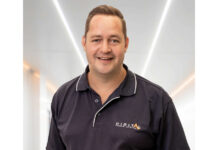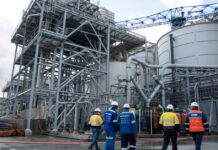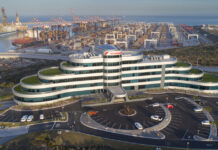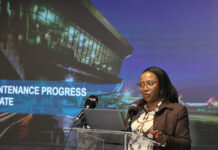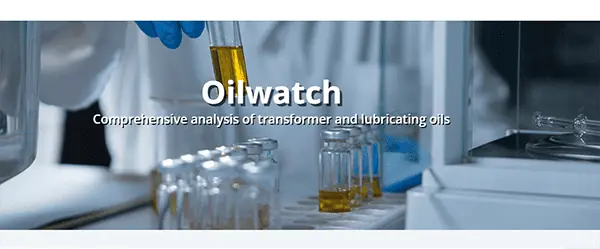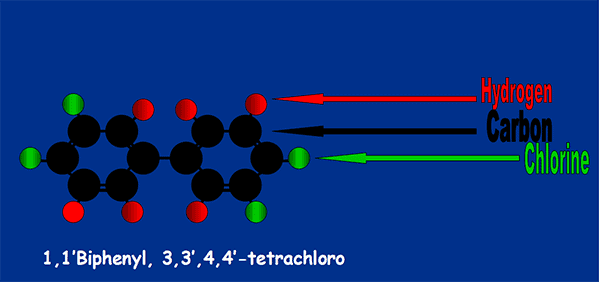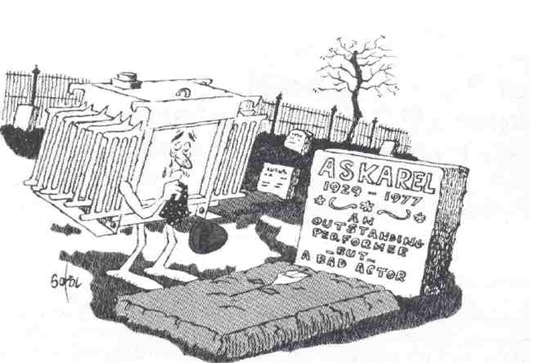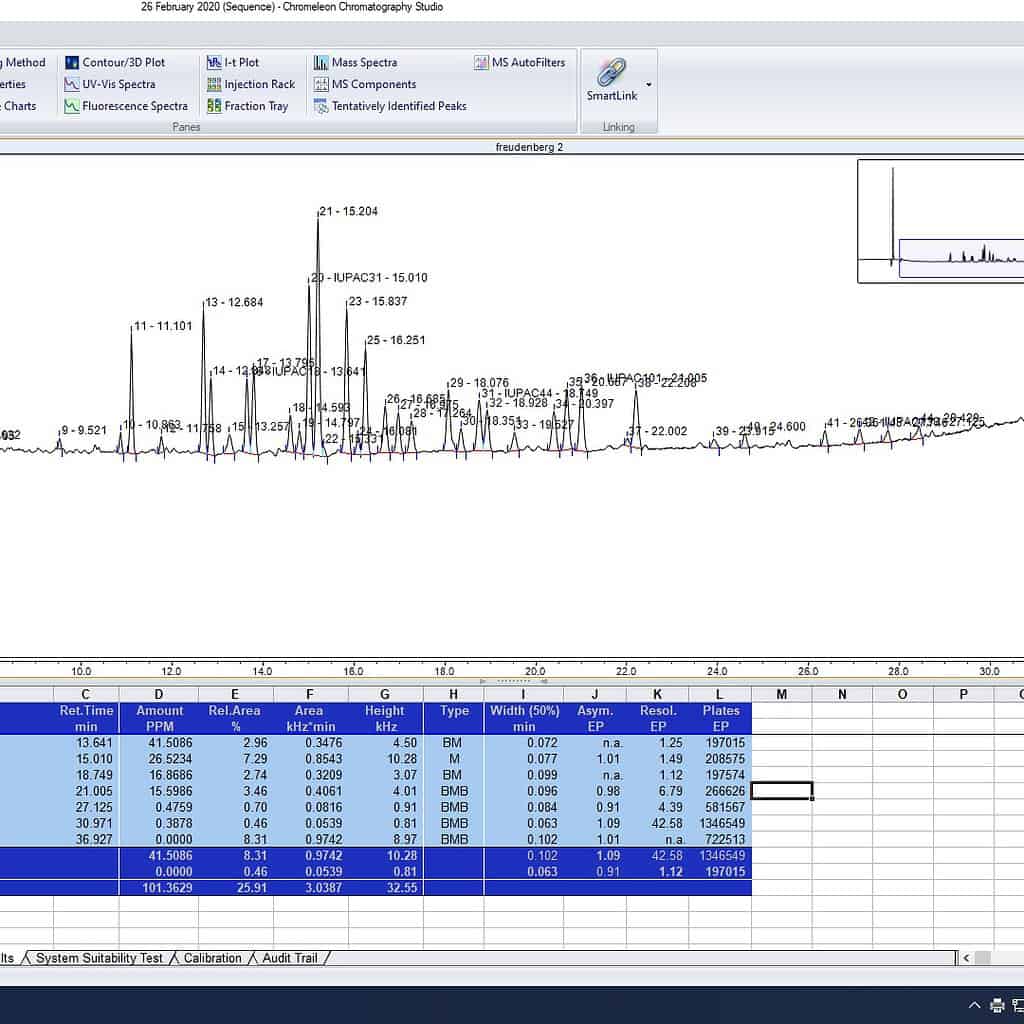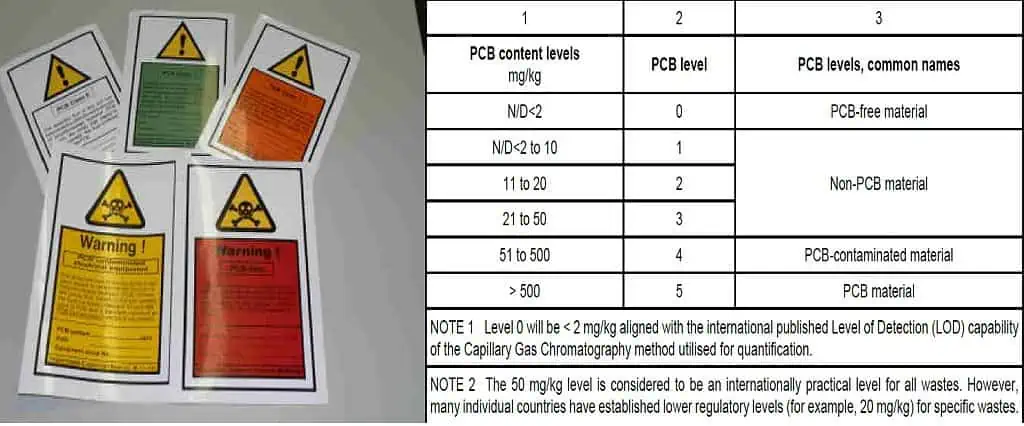By I.A.R. Gray-Oilwatch Transformer Services
What are PCBs?
PCBs (polychlorinated biphenyls) are a group of synthetic oil-like chemicals of the organochlorine family. It was first described in technical literature in 1881 and commercial production commenced in the late 1920’s.
Until their toxic nature was recognized and their use was banned in the early 1980s, they were widely used as insulation in electrical equipment, particularly transformers.
All commercially produced PCB’s are complex mixtures of many different congeners-PCB molecule containing a specific number of chlorine molecules at specific sites)
Figure 1: PCB chemical structure
The PCB molecule consists of two phenyl molecules joined together with two or more hydrogen atoms replaced by chlorine atoms. 209 individual chlorinated biphenyl compounds (congeners) can be created by replacement of chlorine at the various corners of the carbon rings. Three types of PCB are normally used in electrical transformers: Aroclor 1242, 1254 and 1260. The first two digits, designate the number of carbon atoms in the molecule and the last two stand for the weight percentage respectively in each type. PCB has the chemical formula C12H10-nCln where ‘n’ is 1-10. PCB is commonly known by various brand names. These include Askarel, Chlorectol, Elemex, Inerteen, and Pyranol.
Why are they dangerous?
Their toxicity is shown to cause damage to the reproductive, neurological, and immune systems of wildlife and humans and is known to cause cancer. Specifically, because PCBs in the body mimic estrogen, women of child-bearing age and their infants are particularly susceptible to a variety of development and reproductive disorders. A National Academy of Sciences committee has stated that “PCBs pose the largest potential carcinogenic risk of any environmental contaminant for which measurements exist.”
The main reasons for stopping further use are the risks to health and the environment. PCBs are very stable, and their degradation process is slow, it is also biologically accumulative in the food chain.
So, it can be said of PCB, that although it was an outstanding performer, it was a bad actor. (See Figure 2 below)
Far more serious are the risks of a fire or an explosion. At temperatures around 500 degrees C extremely toxic compounds Polychlorinated dibenzfuranes are formed. Small amounts of these compounds have been found at accidents where transformers and capacitors have been exposed to fire or have exploded. Even if the amounts have been extremely small and have caused no personal injuries, it has been necessary to perform very extensive and costly decontamination work.
Table 1 below gives some Toxicology values (LD50), the lower the figure, the higher the toxicity.
Chemical |
LD50 g/Kg
|
| Polychlorinated biphenyl (PCB) | 8.7 |
| Trichloroethylene | 5.2 |
| Acetone | 9.8 |
| Methyl alcohol | 12.9 |
| Polychlorinated dibenzofuranes (PCDD’s and PCDF’s) | <0.001 |
Regulatory levels
PCBs is one of twelve (so called ‘dirty dozen’) Persistent Organic Pollutants (POP’s) governed by UNEP (United Nations Environmental Program) according to the outcome of the Basel Convention that was held in March 1999 and the treaty that was ratified in Sweden in May 2001, with South Africa being a signatory.
Stockholm Convention on persistent Organic Pollutants.
Each part shall:
(a) With regard to the elimination of the use of polychlorinated biphenyls in equipment (e.g. transformers, capacitors or other receptacles containing liquid stocks) by 2025, subject to review by the conference of the Parties, take action in accordance with the following priorities:
(i) Make determined efforts to identify, label and remove from use equipment containing greater than 10 percent polychlorinated biphenyls and volumes greater than 5 litres.
(ii) Make determined efforts to identify, label and remove from use equipment containing greater than 0.05 percent polychlorinated biphenyls and volumes greater than 5 litres.
(iii) Endeavor to identify, label and remove from use equipment containing greater than 0.005 percent polychlorinated biphenyls and volumes greater than 0.05 litres.
(b) Consistent with the priorities in subparagraph (a) promote the following measures to reduce exposures and risks to control the use of polychlorinated biphenyls.
(i) Use only intact and non-leaking equipment and in only in areas where the risk from environmental releases can be minimized and quickly remedied.
(ii) Not use in equipment in areas associated with production or processing of food or feed.
(iii) When used in populated area’s, including schools and hospitals, all reasonable measures to protect from electrical failure which could result in a fire and regular inspection for leaks.
(c) Notwithstanding paragraph 2 of Article 3, ensure that equipment containing polychlorinated biphenyls as described in subparagraph (a) shall be exported or imported except for the purpose of environmentally sound waste management
(d) Except for maintenance and servicing operations, not allow recovery for the purpose of reuse in other equipment of liquids with polychlorinated biphenyls content above 0.005 percent
Legal compliance: South Africa National Implementation Plan.
In line with the requirements of the Convention and realizing the need to take the necessary measure to prevent the harmful impacts of POPs, South Africa has developed its National Implementation plan (NIP) with the following expected outcomes.
- to protect South Africans’ health from the effect of POPs.
- to promote a cleaner South African environment.
- improve South Africa’s capacity to manage POPs.
- to reduce South Africa’s contribution to global pollutant loading.
- to contribute to meeting South Africa’s commitments under the Stockholm Convention.
Phase-out of PCB Materials and PCB Contaminated Materials.
On the 10 July 2014 GN R549 was published in GG 37818, under NEMA (107 of 1998). (See Figure 3 below)
This Regulation deals with the ‘phase-out’ the use of PCB materials and PCB-contaminated materials throughout South Africa.
GN R549 sets the classification limits defining PCB contamination.
The Regulation defines PCB contamination under the following three categories:
- PCB level below 50 mg/kg (about 50ppm) is Non-PCB.
- PCB from 51 mg/kg (>50ppm) to 500mg/kg (500ppm) is PCB Contaminated.
- PCB greater than 500mg/kg (>500ppm) is considered PCB material.
Summary of GN R549 requirement
No person may use any PCB materials or PCB-contaminated materials after the year 2023.
No person may have any PCB materials, PCB-contaminated materials or PCB waste in their possession after the year 2026, excluding disposed PCB waste (applicable to licensed waste handlers).
Any person who possesses “articles”, which include dielectric fluid, dielectric fluid containers, electrical equipment or other equipment or materials that contain PCBs or that came into contact with materials that contain PCBs, must register with the Director-General, within 90 days of the promulgation of these Regulations, i.e., by 10 October 2014, as described in GN R549 Regulation 5 and must follow the requirements as described in Regulation 5, 6, 7, 8 and 9.
The penalties for non-compliance with these regulations are severe and include fines of up to R10 million and/or imprisonment of up to 10 years for the individual/individuals responsible.
Additional Legislation regulations and standards that may apply include.
GN R1179 (GG 16596 of 25 August 1995) Regulations for Hazardous Chemical Substances.
SANS 290 Edition 3- the South African National Standards for Mineral Insulating Oil: Management of polychlorinated biphenyls (PCBs).
MHS Act (29 of 1996) S11: “the employer is to assess and respond to risk”, i.e., where PCBs are present a Risk Assessment must be conducted.
OHS Act (85 of 1993): As required in terms of Section 103 of MHS Act.
NEMA (107 of 1998) S28: Duty of care and remediation of environmental damage by every person who causes, has caused, or may cause significant pollution or degradation of the environment.
NWA (39 of 1998) S19: S19- Responsibility of owner, occupier, user, or person responsible for land must take all reasonable measures to prevent any pollution of a water resource from occurring, continuing or recurring.
NEM:WA (59 of 2008) S14, S16, S19, S21 and S26.
Methods of PCB Analysis
Current methods of analysis are divided into two major groups: PCB Specific and PCB Non-specific.
Non-specific methods test for PCBs indirectly by detecting one of the components of the PCB compound, usually Chlorine. In general, non-specific methods are quicker and less expensive than the specific methods.
The most widely used techniques are X-ray fluorescence, micro-coulometry, colorimetric methods, and electro-chemistry.
This test is susceptible to false positive results, i.e., the test indicates the presence of PCBs when there are no present.
Specific methods utilize some type of chromatography to separate PCB congeners from each other and interfering compounds, is not a case of simply finding an easily quantifiable compound, but of quantifying a complex mixture of compounds. Of the three major chromatography types, gas chromatography (GC), thin layer chromatography (TLC) and liquid chromatography, GC is the preferred and most extensively used method.
The most frequently used method of detection for GC is the electron capture detector (ECD). This is not truly PCB specific where Mass spectrometry (MS) is the most specific detector that is used with GC. This technique reveals the actual mass of the compound being analysed, providing a “fingerprint” of the compound that can be mistaken for no other. GC-MS analysis requires highly trained analysts and expensive equipment.
Figure 4 Below: Chromatogram of PCB contaminated oil (Test method IEC 61619)
Testing Laboratories
The owners of Fluid insulated electrical equipment need to consider the requirements of Legislation and SANS 290 Edition 3 when selecting the analytical method, it is important to verify the capability of the analytical laboratory namely “PCB concentration determinations and PCB analyses shall be performed in accordance with IEC 61619, ASTM D4059 or EPA 600/4-81-045. PCB determination shall be done in a test laboratory that has been accredited in accordance with SANS 17025”.
NOTE Laboratory certificates accredited or issued by the relevant national body have a legal status as given in the relevant national legislation.
PCB Proficiency Testing
Worldwide there has been a lack of reproducibility of results due to the complexity of the analysis.
(as seen in figure 4), this issue has been identified by various International PCB proficiency testing (Institute for Interlaboratory Studies (See Table 1 Below) and the Local Eskom program.
The local program has shown an improvement in reproducibility over the years but unfortunately Eskom has made the decision to discontinue this program.
Oilwatch Transformer Services as a SANS/ISO 17025 accredited Laboratory has taken the initiative to continue with this Local program in the national interest and as such can be contacted in this regard.
NOTE Under Good Laboratory Practice (GLP), it is recommended to establish a ring test inter-calibration exercise among the participating labs to verify that the results from the different laboratories are comparable.
Table 2: Results from (Institute of Interlaboratory Studies-Netherlands)
| Laboratory Number | Method | Arochlor 1242 | Arochlor 1254 | Arochlor 1260 | Mark | % Dev(∑) |
| 511 | <1 | <1 | 7,97 | -49,43 | ||
| 614 | D4059 | <2 | <2 | 7,90 | -49,88 | |
| 912 | D4059 | 0,29 | 0,20 | 1,20 | Outlier | -81,34 |
| 1072 | In house | 1,58 | 15,47 | 13,87 | -11,99 | |
| 1170 | D4059 | 1,21 | <2 | 17,71 | 12,36 | |
| 1303 | D4059 | <2 | <2 | 20,54 | 30,33 | |
| 1304 | INH-127 | 1,21 | <2 | 12,88 | -18,27 | |
| 1306 | In house | 1,31 | 14,47 | -8,19 | ||
| 1352 | In house | 1,14 | 1,44 | 14,53 | -7,81 | |
| 1374 | D4059 | 0,96 | <2 | 15,59 | -1,09 | |
| 1440 | In house | 2,00 | <2 | 18,00 | 14,20 | |
| 1458 | D4059 | 0,15 | 0,78 | 20,34 | 29,06 | |
| 1505 | D4059 | 2,50 | <2 | 26,80 | Outlier | 70,04 |
| 1660 | IEC61619 | <2 | <2 | 20,83 | 32,16 | |
| 1841 | IEC61619 | <2 | <2 | 16,65 | 5,64 | |
| 2122 | 8,23 | 18,62 | 18,15 | |||
| SA Lab 1 | In house | 9,80 | -37,82 | |||
| SA Lab 2 | D4059 | 26,00 | Outlier | 64,96 | ||
| ave | 1,23 | 4,57 | 15,76 | |||
| std dev | 0,75 | 6,10 | 6,41 | |||
| ESDM | 0,33 | 2,73 | 2,87 | |||
| %RSD | 60,83 | 133,41 | 40,69 |
Note: The study shows IEC 61619 is the more robust method due to various technical reasons:
Management system: Labelling and Inventory control
Owners of Oil filled Electrical equipment shall establish a management system and know their responsibilities in line with national law, regulations, and priorities.
The Labelling is just one such requirement: See Figure 5 PCB Labels and SANS 290 Classification
Another requirement is to categorise and visualising the data, and for example show all locations with PCB transformers on a map with appropriate coordinates, to this end Oilwatch has developed a sampling app that interfaces with a data base to provide this functionality.
Please contact Oilwatch for more information.
CHALLENGES FACING Southern Africa
Limited testing facilities (Accredited 17025).
Vast numbers of untested equipment (currently not on track to achieve the GN R549 requirement)
Note: Systematic and harmonized PCB inventories of equipment containing or contaminated with PCB are key to achieving the goals of the Stockholm Convention.
It is important to consider that setting up a national PCB inventory is a dynamic process as it needs to be regularly updated to reflect changes in stocks. It is also important to include information on the complete lifecycle of the equipment.
Lack of knowledge and Owners are not aware of legislation.
Disposal options and expertise are limited and doing the wrong thing is easier – blending.
Blending PCB contaminated oil with virgin or other oil to meet the legal requirements is a violation of the outcome of the Basel convention that specifically states, “Many cases of illegal traffic will take the form of deliberate mixing of hazardous waste with non-hazardous waste, it spreads PCBs into virgin oil and thus ensure that we will never have PCB free oil in future”.
Owners of PCB equipment also have a moral and environmental responsibility to handle the PCB issue in the right way but unfortunately it comes with costs.
The Way Forward
- Awareness and stakeholder participation
- Adequate inventory approaches
- PCB sampling and testing
- Addressing cross-contamination
Environmentally Sound Management of PCB is key for a healthy planet. A healthy environment and healthy food reduce people’s exposure to toxic chemicals.
support@oilwatch.co.za

